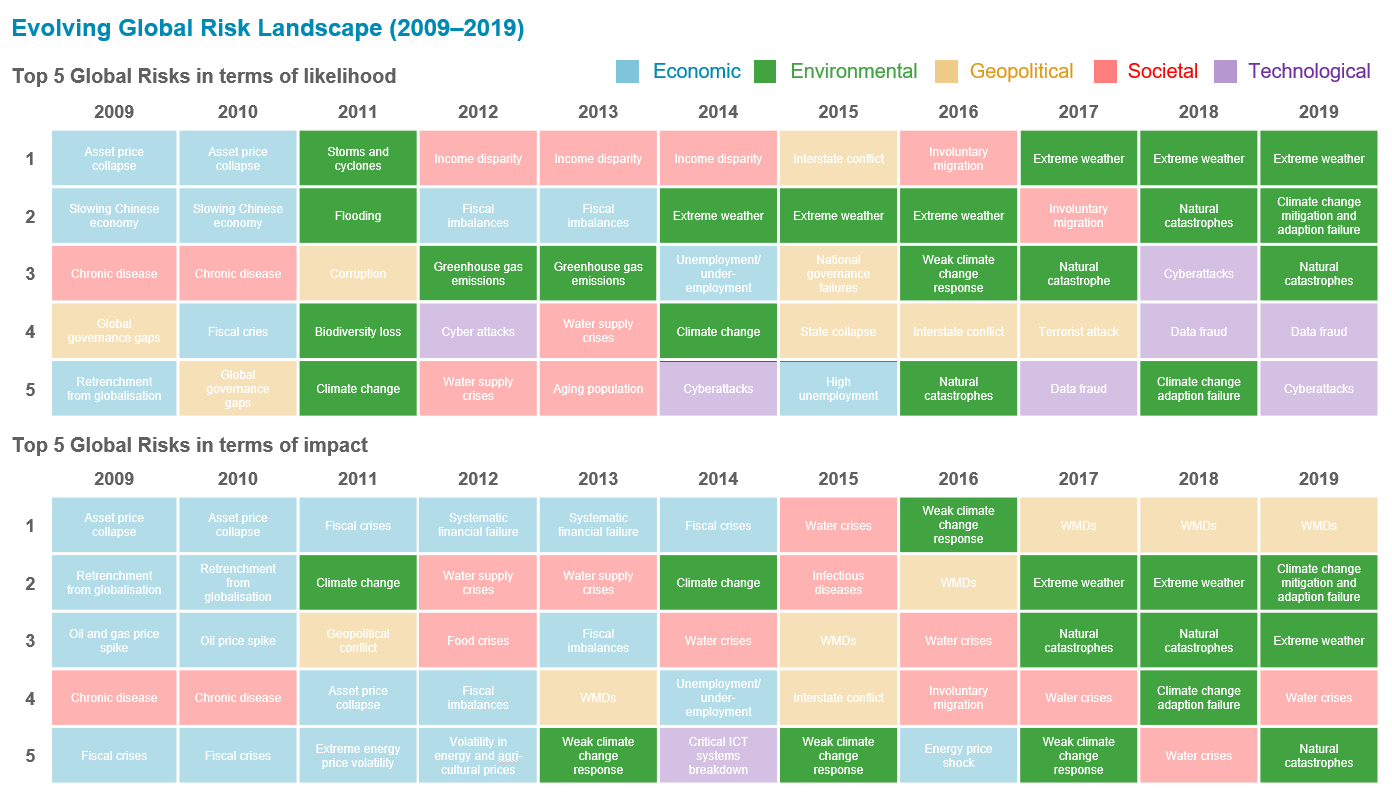By Robert Bailey and Jaclyn Yeo
Environmental risks have come to dominate the rankings of the annual global risk perception survey that underpins the Global Risk Report. In the 2019 edition, environmental and climate-related risks accounted for three of the top five risks by likelihood and four by impact (Exhibit 1).
Exhibit 1: Environmental risks have surpassed economic risks as issues of greatest concern

Extreme weather, failure of climate change mitigation and adaptation, and natural catastrophes have been among the top five global risks for three years running. The threat of coastal flooding sits at the nexus of all three and it is becoming more likely and more severe.
For example, in the US, the frequency of high-tide coastal flooding has doubled over the past 30 years according to the National Oceanic and Atmospheric Administration. Asia experienced a series of high-tide floods and destructive typhoons in 2018, while a recent study estimated the economic damage resulting from coastal flooding in Europe could cost EUR1 trillion annually by 2100. This is a multi-fold increase on the 2018 figures at less than EUR2 billion.
The risk of coastal flooding is increasing due to powerful underlying trends. Rapid urbanization means that economic assets and human populations are becoming increasingly concentrated in low-lying coastal regions, many of which are vulnerable to subsidence. Eight of the 10 global megacities (with populations greater than 8 million) are located near the coast. Climate change is leading to sea level rise, as glaciers melt, and warming oceans expand. Warmer temperatures are also resulting in stronger and wetter storms, which combine with rising sea levels to create more damaging storm surges.
Looking to the future, these trends are set to continue. In many countries, coastal cities are expected to grow significantly, placing more people and assets at risk on land that is sinking. Even if warming is limited to 2°C above pre-industrial levels, the IPCC estimates sea levels may rise by up to 0.93 meters by 2100, with other estimates more than twice this. And sea level rise will continue long beyond the end of this century, eventually reaching 6 meters with a 2°C temperature increase. And the chances of limiting warming to this level currently look slim: national pledges to reduce emissions are consistent with a global temperature increase of more than 3°C. On current trajectories, large coastal cities could see flood losses increase by a factor of ten by 2050.
The cost of floods in such densely populated centres of economic activity extends far beyond property damage. Damage to critical infrastructure can curtail access to power, food, clean water and sanitation with serious implications for public health. Businesses and supply chains can be disrupted, bringing economic activity to a halt. Table 1 presents a host of direct and indirect losses due to flooding.
Table 1 Floods can have multi-faceted impacts on infrastructure, people and business
|
Direct Losses |
Indirect Losses |
Monetary (tangible) |
Buildings and contents, Infrastructure, rail system, vehicles, agriculture and crops, livestock |
Disruption to transportation network, business interruption, legal and litigation costs, economic decline |
Non-monetary (intangible) |
Injuries and fatalities, recovery and rescue efforts, damage to cultural and/or heritage sites, ecological damage, urban migration |
Stress and anxiety, disruption to living, loss of community, loss of cultural and environmental sites, ecosystem resource loss |
Cities, and the populations and businesses operating within them, must adapt to this future. Strategies include building defensive infrastructure such as sea walls and flood defences and restoring natural infrastructure such as mangroves and salt marshes. Urban planning and new construction projects must account for future expectations of flood risk and avoid ‘locking in’ vulnerability.
However, such defensive measures cannot eliminate risk entirely and will often be expensive, unpopular, or both. Furthermore, as the affordability of flood resilience becomes an increasingly important issue, the question of who bears the costs will become more pertinent.
Innovative risk financing strategies will be needed. Parametric insurance that pays out quickly on a pre-defined trigger can allow municipal governments or businesses to finance rapid response and recovery operations or cover the costs of business interruption; public-private partnerships and risk pooling mechanisms can share the costs of risk among different stakeholders. Innovation and collaboration will be key to managing coastal flood risk in the future.

